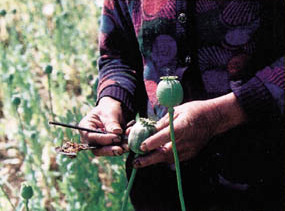|
Morphine
Morphine, formerly also called morphia, is an opiate that is found naturally in opium, a dark brown resin produced by drying the latex of opium poppies (''Papaver somniferum''). It is mainly used as an analgesic (pain medication). There are multiple methods used to administer morphine: oral; sublingual administration, sublingual; via inhalation; intramuscular, injection into a muscle, Subcutaneous injection, injection under the skin, or injection into the spinal cord area; transdermal; or via rectal administration, rectal suppository. It acts directly on the central nervous system (CNS) to induce analgesia and alter perception and emotional response to pain. Physical and psychological dependence and tolerance may develop with repeated administration. It can be taken for both acute pain and chronic pain and is frequently used for pain from myocardial infarction, kidney stones, and during Childbirth, labor. Its maximum effect is reached after about 20 minutes when administ ... [...More Info...] [...Related Items...] OR: [Wikipedia] [Google] [Baidu] |
Opium
Opium (also known as poppy tears, or Lachryma papaveris) is the dried latex obtained from the seed Capsule (fruit), capsules of the opium poppy ''Papaver somniferum''. Approximately 12 percent of opium is made up of the analgesic alkaloid morphine, which is processed chemically to produce heroin and other synthetic opioids for medicinal use and for the illegal drug trade. Opium's main psychoactive alkaloids, primarily morphine, act on μ-opioid receptors, causing analgesia and addiction with long-term use leading to tolerance, dependence, and increased cancer risk. The latex also contains the closely related opiates codeine and thebaine, and non-analgesic alkaloids such as papaverine and noscapine. The traditional, labor-intensive method of obtaining the latex is to scratch ("score") the immature seed pods (fruits) by hand; the latex leaks out and dries to a sticky yellowish residue that is later scraped off and dehydrated. The English word for opium is loan word, borrowed fro ... [...More Info...] [...Related Items...] OR: [Wikipedia] [Google] [Baidu] |
Opiate
An opiate is an alkaloid substance derived from opium (or poppy straw). It differs from the similar term ''opioid'' in that the latter is used to designate all substances, both natural and synthetic, that bind to opioid receptors in the brain (including antagonists). Opiates are alkaloid compounds naturally found in the opium poppy plant ''Papaver somniferum''. The psychoactive compounds found in the opium plant include morphine, codeine, and thebaine. Opiates have long been used for a variety of medical conditions, with evidence of opiate trade and use for pain relief as early as the eighth century AD. Most opiates are considered drugs with moderate to high abuse potential and are listed on various "Substance-Control Schedules" under the Uniform Controlled Substances Act of the United States of America. In 2014, between 13 and 20 million people used opioids recreationally, representing 0.3% to 0.4% of the global population between the ages of 15 and 65. According to the CDC, ... [...More Info...] [...Related Items...] OR: [Wikipedia] [Google] [Baidu] |
Morphine-6-glucuronide
Morphine-6-glucuronide (M6G) is a major active metabolite of morphine. M6G is formed from morphine by the enzyme UGT2B7. It has analgesic effects roughly half that of morphine. M6G can accumulate to toxic levels in kidney failure. History of discovery This analgesic activity of M6G (in animals) was first noted by Yoshimura. Subsequent work at St Bartholomew's Hospital, London in the 1980s, using a sensitive and specific high-performance liquid chromatography assay, accurately defined for the first time the metabolism of morphine, and the abundance of this metabolite (along with morphine-3-glucuronide, considered an inactive metabolite). It was postulated that kidney impairment would result in accumulation of the kidney-excreted active agent M6G, leading to potentially fatal toxicity such as respiratory depression. The frequent use of morphine in critically ill patients, and the common occurrence of kidney failure in this group implied that M6G accumulation could be a common ... [...More Info...] [...Related Items...] OR: [Wikipedia] [Google] [Baidu] |
Morphine-3-glucuronide
Morphine-3-glucuronide is a metabolite of morphine produced by UGT2B7. It is not active as an opioid agonist, but does have some action as a convulsant, which does not appear to be mediated through opioid receptors, but rather through interaction with glycine and/or GABA receptors. As a polar compound, it has a limited ability to cross the blood–brain barrier, but kidney failure may lead to its accumulation and result in seizures. Probenecid and inhibitors of P-glycoprotein can enhance uptake of morphine-3-glucuronide and, to a lesser extent, morphine-6-glucuronide. Reported side effects related to the accumulation of this metabolite include convulsions, agitation, hallucinations, hyperalgesia, and coma. See also * 3-Monoacetylmorphine, the inactive 3,- position blocked by esterization (and thus inactive) of a semi-synthetic prodrug to morphine marking the same activity profile as the drug of this article * Buprenorphine-3-glucuronide * Morphine-6-glucuronide Morphine ... [...More Info...] [...Related Items...] OR: [Wikipedia] [Google] [Baidu] |
Analgesia
Pain management is an aspect of medicine and health care involving relief of pain (pain relief, analgesia, pain control) in various dimensions, from acute and simple to chronic and challenging. Most physicians and other health professionals provide some pain control in the normal course of their practice, and for the more complex instances of pain, they also call on additional help from a specific medical specialty devoted to pain, which is called pain medicine. Pain management often uses a multidisciplinary approach for easing the suffering and improving the quality of life of anyone experiencing pain, whether acute pain or chronic pain. Relieving pain (analgesia) is typically an acute process, while managing chronic pain involves additional complexities and ideally a multidisciplinary approach. A typical multidisciplinary pain management team may include: medical practitioners, pharmacists, clinical psychologists, physiotherapists, occupational therapists, recreationa ... [...More Info...] [...Related Items...] OR: [Wikipedia] [Google] [Baidu] |
Papaver Somniferum
''Papaver somniferum'', commonly known as the opium poppy or breadseed poppy, is a species of flowering plant in the family Papaveraceae. It is the species of plant from which both opium and poppy seeds are derived and is also a valuable ornamental plant grown in gardens. Its native range was the eastern Mediterranean region, but has since been obscured by widespread introduced species, introduction and Horticulture, cultivation since ancient times to the present day. It is now Naturalisation (biology), naturalized across much of the world with temperate climates. This poppy is grown as an agricultural crop on a large scale, for one of three primary purposes: to produce poppy seeds, to produce opium (for use mainly by the pharmaceutical industry), and to produce other alkaloids (mainly thebaine and oripavine) that are processed by pharmaceutical companies into drugs such as hydrocodone and oxycodone. Each of these goals has special breeds that are targeted at one of these busine ... [...More Info...] [...Related Items...] OR: [Wikipedia] [Google] [Baidu] |
Analgesic
An analgesic drug, also called simply an analgesic, antalgic, pain reliever, or painkiller, is any member of the group of drugs used for pain management. Analgesics are conceptually distinct from anesthetics, which temporarily reduce, and in some instances eliminate, sensation, although analgesia and anesthesia are neurophysiologically overlapping and thus various drugs have both analgesic and anesthetic effects. Analgesic choice is also determined by the type of pain: For neuropathic pain, recent research has suggested that classes of drugs that are not normally considered analgesics, such as tricyclic antidepressants and anticonvulsants may be considered as an alternative. Various analgesics, such as many NSAIDs, are available over the counter in most countries, whereas various others are prescription drugs owing to the substantial risks and high chances of overdose, misuse, and addiction in the absence of medical supervision. Etymology The word ''analgesic'' derive ... [...More Info...] [...Related Items...] OR: [Wikipedia] [Google] [Baidu] |
UGT2B7
UGT2B7 (UDP-Glucuronosyltransferase-2B7) is a phase II metabolism isoenzyme found to be active in the liver, kidneys, epithelial cells of the lower gastrointestinal tract and also has been reported in the brain. In humans, UDP-Glucuronosyltransferase-2B7 is encoded by the ''UGT2B7'' gene. Function The UGTs serve a major role in the conjugation and subsequent elimination of potentially toxic xenobiotics and endogenous compounds. UGT2B7 has unique specificity for 3,4- catechol estrogens and estriol, suggesting that it may play an important role in regulating the level and activity of these potent estrogen metabolites. This enzyme is located on the endoplasmic reticulum and nuclear membranes of cells. Its function is to catalyse the conjugation of a wide variety of lipophilic aglycon substrates with glucuronic acid, using uridine diphosphate glucuronic acid. Together with UGT2B4, UGT2B7 is capable of glucosidation of hyodesoxycholic acid in the liver, but, unlike the ... [...More Info...] [...Related Items...] OR: [Wikipedia] [Google] [Baidu] |
Myocardial Infarction
A myocardial infarction (MI), commonly known as a heart attack, occurs when Ischemia, blood flow decreases or stops in one of the coronary arteries of the heart, causing infarction (tissue death) to the heart muscle. The most common symptom is retrosternal Angina, chest pain or discomfort that classically radiates to the left shoulder, arm, or jaw. The pain may occasionally feel like heartburn. This is the dangerous type of acute coronary syndrome. Other symptoms may include shortness of breath, nausea, presyncope, feeling faint, a diaphoresis, cold sweat, Fatigue, feeling tired, and decreased level of consciousness. About 30% of people have atypical symptoms. Women more often present without chest pain and instead have neck pain, arm pain or feel tired. Among those over 75 years old, about 5% have had an MI with little or no history of symptoms. An MI may cause heart failure, an Cardiac arrhythmia, irregular heartbeat, cardiogenic shock or cardiac arrest. Most MIs occur d ... [...More Info...] [...Related Items...] OR: [Wikipedia] [Google] [Baidu] |
Chronic Pain
Chronic pain is pain that persists or recurs for longer than 3 months.https://icd.who.int/browse/2025-01/mms/en#1581976053 It is also known as gradual burning pain, electrical pain, throbbing pain, and nauseating pain. This type of pain is in contrast to acute pain, which is pain associated with a cause that can be relieved by treating the cause, and decreases or stops when the cause improves. Chronic pain can last for years. Persistent pain often serves no apparent useful purpose. The most common types of chronic pain are back pain, severe headache, migraine, and facial pain. Chronic pain can cause very severe psychological and physical effects that sometimes continue until the end of life. Analysis of the grey matter (damage to brain neurons), insomnia and sleep deprivation, metabolic problems, chronic stress, obesity, and heart attack are examples of physical disorders; and Depression (mood), depression, and neurocognitive disorders are examples of mental disorders. A wide ra ... [...More Info...] [...Related Items...] OR: [Wikipedia] [Google] [Baidu] |
Acute Pain
Pain is a distressing feeling often caused by intense or damaging Stimulus (physiology), stimuli. The International Association for the Study of Pain defines pain as "an unpleasant sense, sensory and emotional experience associated with, or resembling that associated with, actual or potential tissue damage." Pain motivates organisms to withdraw from damaging situations, to protect a damaged body part while it heals, and to avoid similar experiences in the future. Congenital insensitivity to pain may result in reduced life expectancy. Most pain resolves once the noxious stimulus is removed and the body has healed, but it may persist despite removal of the stimulus and apparent healing of the body. Sometimes pain arises in the absence of any detectable stimulus, damage or disease. Pain is the most common reason for physician consultation in most developed countries. It is a major symptom in many medical conditions, and can interfere with a person's quality of life and general fun ... [...More Info...] [...Related Items...] OR: [Wikipedia] [Google] [Baidu] |








